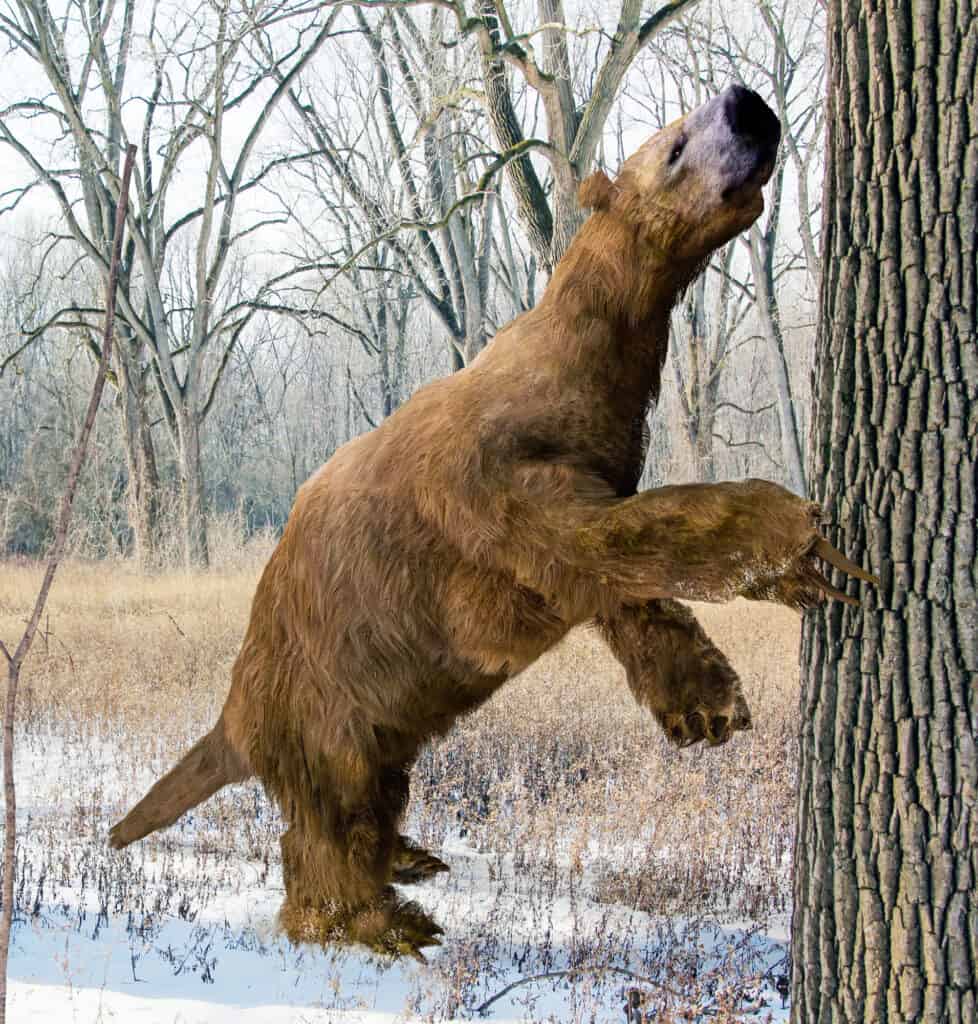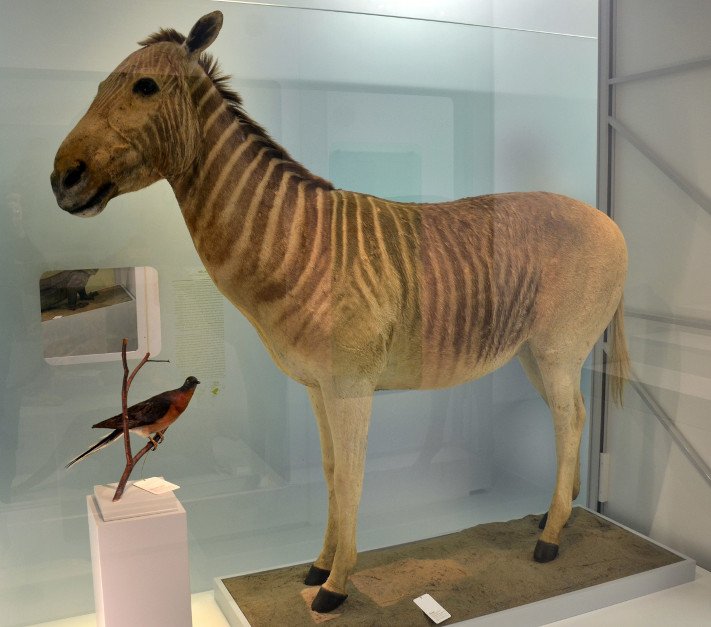Most news about extinction is dismal but it doesn’t have to be. Sometimes it’s okay to smile about something that has gone extinct because it was so darned cute. What are some of the cute extinct animals that existed on earth but are now gone forever?
Looking cute to humans is an adaptation found in some modern animals like dogs. While cute extinct animals didn’t evolve into their cuteness on purpose, the fact remains that they’re still adorable. Endangered cute animals like polar bears didn’t mean to be cute either, but we still adore them.
What are some of the cute extinct animals that used to exist but are gone forever? Let’s take a closer look at seven of these cute extinct animals.
7 Cute Extinct Animals That Are Gone Forever
These are seven of the cutest extinct animals that are now gone forever:
- Giant Sloth
- Toolache Wallaby
- Quagga
- Great Auk
- Tasmanian Tiger
- Sea Mink
- Giant Beaver
1. The Cute Giant Sloth is Extinct

The largest giant sloth lived in the Americas and weighed four tons.
©Aunt Spray/Shutterstock.com
An elephant-sized sloth sounds cute because we imagine it with the same weird sloppy grin of today’s upside-down sloths, except gigantic. The truth is, however, that no one is exactly sure what the giant sloth looked like. It was most likely as super cute as we imagine, though.
Around 10,000 years ago, megafauna across the planet went extinct. This included the giant sloth. Debates still rage about what drove this large group of plants and animals to extinction, but most agree it was due to overhunting by humans and climate change.
As temperatures warmed at the end of the last ice age, conditions in the riverine grasslands that these sloths loved became hotter and wetter. This altered the food scene and starved the giant sloths. Some giant sloth remains from over 12,000 years ago show evidence of human butchery as well.
There were at least 23 different kinds of giant sloths. The largest of them lived in the Americas. While they generally died out 10,000 years ago, small giant sloth populations probably held on for another 5,000 years on isolated islands.
The largest giant sloths were up to 20 feet long from head to tail and weighed up to 4 tons. Their claws were around seven inches long and they used them to strip tree branches. Their massive size meant they weren’t at risk of predation by most of the animals they encountered.
2. The Cute Toolache Wallaby is Extinct
The Toolache wallaby was cute because it looked like a dapper kangaroo. Both its graceful movements and starkly colored nose, hands, and feet made it seem more formalized and polished than the marsupials left on the earth today.
Hunting and the invasive red fox drove the Toolache wallaby to extinction. A conservation effort was undertaken but it accidentally resulted in the death of 10 of the 14 remaining individuals in the wild. In 1943, the Toolache wallaby of southeastern Australia was officially declared extinct.
3. The Cute Quagga is Extinct

Taxidermied quagga in the Naturhistorisches Museum of Basel. Quagga (Equus quagga quagga) is an extinct sub-species of
zebra
.
©Vassil / CC0 1.0 – License
This zebra spinoff is cute because it looks like a horse and a zebra that were grafted together. It diverged from modern zebras about 200,000 years ago. The quagga’s name is onomatopoeic, which means it stands for the audible sound the animal made.
Quaggas lived in South Africa in and near the Karoo Region in Cape Province. This area is an arid grassland with shrubbery. In 1883, the last captive quagga died at the Artis Magistra Zoo in Amsterdam. Quagga meat and hides were valuable, and they competed with livestock for food. Now there are only five photographs of one living quagga from the London Zoo, and almost two dozen surviving taxidermied quaggas still in existence.
In 1987, the Quagga Project was launched. While it won’t raise true quagga from the dead, it’s an effort focused on breeding extant zebras so they are a lot like a quagga. So far, the Quagga Project has resulted in individuals that look almost like extinct quaggas.
4. The Cute Great Auk is Extinct
Great auks are cute for the same reason that emperor penguins are cute — they look like they’re wearing little tuxedos! While they look a lot like penguins, however, they aren’t closely related to them.
These birds occupied ranges in Great Britain, Canada, Spain, Norway, and other locations. While they had adapted to be flightless, great auks were powerful swimmers that relied on the ocean for fish. They nested on cliffs that sloped into the water.
Great auks were easily spotted birds and were hunted en masse in the 16th century as a source of down for pillows. As it became known that their numbers were dwindling, wealthy Europeans collected eggs which irrevocably damaged their numbers. The last recorded sighting of a great auk was in 1852. The British Parliament did try to protect these birds in the 1770s, but it wasn’t in time.
5. The Cute Tasmanian Tiger is Extinct

The Tasmanian
Tiger
(
Thylacinus cynocephalus) was a carnivorous marsupial in Australia, Tasmania, and New Guinea.
©Adwo/Shutterstock.com
Tasmanian tigers are cute because they look like a cat-dog hybrid that underwent a zebra-pattern spray paint job. The juxtaposition of the cutest features of some of our other favorite animals makes the Tasmanian tiger especially appealing.
Humans have represented Tasmanian tigers in cave drawings since 1,000 BCE. These animals were marsupials with a pouch like a kangaroo though they stood on all fours. They lived in Australia, Tasmania, and New Guinea. Tasmanian tigers were apex predators that ate possums, wallabies, bandicoots, and wombats.
These animals were gone by the 1930s after years of overhunting. They were a nuisance to farmers because Tasmanian tigers ate chickens and sheep. However, humans were just the linchpin in their demise as they were already on the decline before people showed up. There have been hundreds of accounts of Tasmanian tiger sightings since their extinction, but none of them are verified.
There are efforts to bring the Tasmanian tiger back. DNA was obtained but it was too corrupted to create a viable clone. There are preserved pouch joeys that may prove promising in obtaining a better DNA sample.
6. The Cute Sea Mink is Extinct
Sea minks are cute because they look like enlarged water squirrels. They were the largest minks in North America and were hunted to extinction by fur trappers. The last individual was hunted in 1894 though it wasn’t officially documented until 1903. An ornithologist was able to identify the extinct sea mink among fur and skeletal specimens from fur traders.
Sea minks lived in the Atlantic Northeast in and around the Gulf of Maine. They were similar to the American mink and they had tails that reached 10 inches in length. This made their furs especially valuable.
7. The Giant Beaver is Extinct

A replica statue of a Giant Beaver, accurate as to size estimates.
©LP Primeau/Shutterstock.com
Since little beavers are cute, that means that a giant beaver is even cuter. Giant beavers were about the size of a bear, and they went extinct with other megafaunas about 10,000 years ago. They stood over seven feet tall and weighed over 200 lbs.
Giant beavers were herbivores that ate more aquatic vegetation than woody plants. They liked marshes and swamps because they probably fed on aquatic plants. They weren’t closely related to the beavers around today though they looked a lot alike.
Giant beavers were most populous in the Midwest though they lived throughout the United States. Some fossils have been found as far north as Alaska. The first giant beaver fossil was unearthed in the mid-1800s in Ohio.
Up Next:
- The 9 Coolest Extinct Animals to Ever Walk the Earth
- 4 Animals That Have Gone Extinct in 2022 (Or Probably Will)
- The 7 Weirdest Extinct Animals
- Discover 5 Extinct Types of Bears!
The photo featured at the top of this post is © miha de/Shutterstock.com
Thank you for reading! Have some feedback for us? Contact the AZ Animals editorial team.






